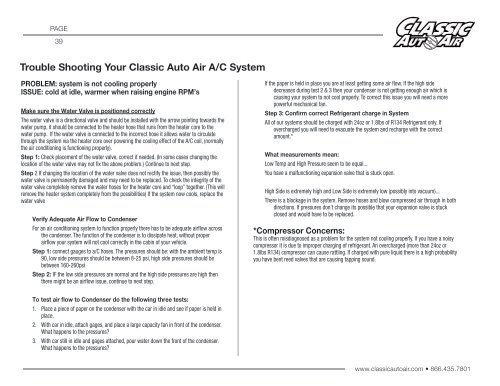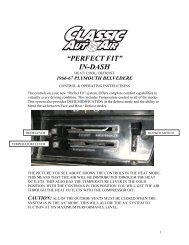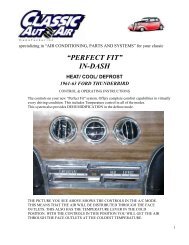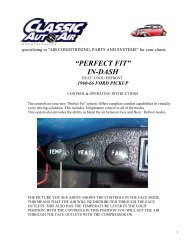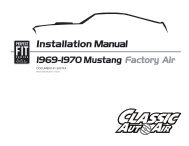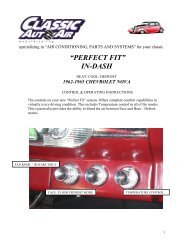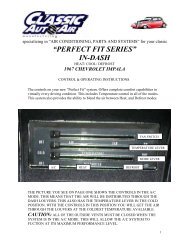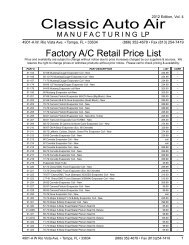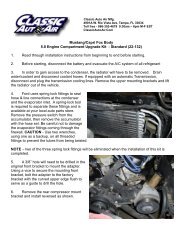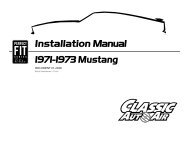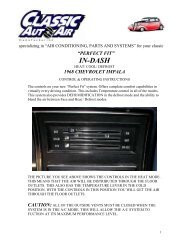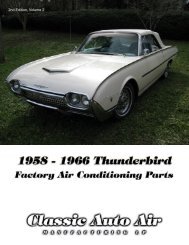1969 Camaro Firebird - Classic Auto Air
1969 Camaro Firebird - Classic Auto Air
1969 Camaro Firebird - Classic Auto Air
Create successful ePaper yourself
Turn your PDF publications into a flip-book with our unique Google optimized e-Paper software.
PAGE<br />
39<br />
Trouble Shooting Your <strong>Classic</strong> <strong>Auto</strong> <strong>Air</strong> A/C System<br />
PROBLEM: system is not cooling properly<br />
ISSUE: cold at idle, warmer when raising engine RPM’s<br />
Make sure the Water Valve is positioned correctly<br />
The water valve is a directional valve and should be installed with the arrow pointing towards the<br />
water pump, it should be connected to the heater hose that runs from the heater core to the<br />
water pump. If the water valve is connected to the incorrect hose it allows water to circulate<br />
through the system via the heater core over powering the cooling effect of the A/C coil, (normally<br />
the air conditioning is functioning properly).<br />
Step 1: Check placement of the water valve, correct if needed. (In some cases changing the<br />
location of the water valve may not fix the above problem.) Continue to next step.<br />
Step 2 If changing the location of the water valve does not rectify the issue, then possibly the<br />
water valve is permanently damaged and may need to be replaced. To check the integrity of the<br />
water valve completely remove the water hoses for the heater core and “loop” together. (This will<br />
remove the heater system completely from the possibilities) If the system now cools, replace the<br />
water valve<br />
Verify Adequate <strong>Air</strong> Flow to Condenser<br />
For an air conditioning system to function properly there has to be adequate airflow across<br />
the condenser. The function of the condenser is to dissipate heat, without proper<br />
airflow your system will not cool correctly in the cabin of your vehicle.<br />
Step 1: connect gauges to a/C hoses. The pressures should be: with the ambient temp is<br />
90, low side pressures should be between 8-25 psi, high side pressures should be<br />
between 160-260psi<br />
Step 2: IF the low side pressures are normal and the high side pressures are high then<br />
there might be an airflow issue, continue to next step.<br />
If the paper is held in place you are at least getting some air flow. If the high side<br />
decreases during test 2 & 3 then your condenser is not getting enough air which is<br />
causing your system to not cool properly. To correct this issue you will need a more<br />
powerful mechanical fan.<br />
Step 3: Confirm correct Refrigerant charge in System<br />
All of our systems should be charged with 24oz or 1.8lbs of R134 Refrigerant only. If<br />
overcharged you will need to evacuate the system and recharge with the correct<br />
amount.*<br />
What measurements mean:<br />
Low Temp and High Pressure seem to be equal...<br />
You have a malfunctioning expansion valve that is stuck open.<br />
High Side is extremely high and Low Side is extremely low (possibly into vacuum)...<br />
There is a blockage in the system. Remove hoses and blow compressed air through in both<br />
directions. If pressures don’t change its possible that your expansion valve is stuck<br />
closed and would have to be replaced.<br />
*Compressor Concerns:<br />
This is often misdiagnosed as a problem for the system not cooling properly. If you have a noisy<br />
compressor it is due to improper charging of refrigerant. An overcharged (more than 24oz or<br />
1.8lbs R134) compressor can cause rattling. If charged with pure liquid there is a high probability<br />
you have bent reed valves that are causing tapping sound.<br />
To test air flow to Condenser do the following three tests:<br />
1. Place a piece of paper on the condenser with the car in idle and see if paper is held in<br />
place.<br />
2. With car in idle, attach gages, and place a large capacity fan in front of the condenser.<br />
What happens to the pressures<br />
3. With car still in idle and gages attached, pour water down the front of the condenser.<br />
What happens to the pressures<br />
www.classicautoair.com • 866.435.7801


